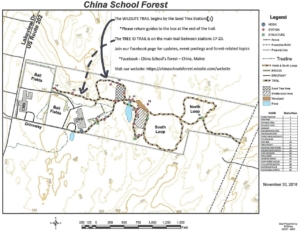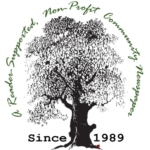China School’s Forest opens a new trail
Anita Smith in the China School’s Forest. (photo by Jeanne Marquis)
by Jeanne Marquis
China School’s Forest opens the North Loop trail after a team of volunteers cleared brush and fallen trees. It has been twenty years since this portion of the forest had been opened for hikers. The North Loop trail is easy to find heading down the main trail toward the power lines, and it will soon be marked by a sign.
Anita Smith, director of the China School’s Forest, explained, “It was originally part of the logging trails that were used when the logging was done back in the mid 90s. We were always more focused on the loops closer to the schools and creating outdoor classrooms. It [Opening this trail] was lower on the priority list of the things we wanted to do, but now with the resurgence of people interested in trails and getting outside, we decided now’s the time to get it done.”
Graphic by Troy and Anita Smith
As you head out to the North Loop you may pass a portion of the “Story Walk.” These are posters that contain pages from a story that lead students through their hike adding to their experience. This story, entitled “Who Pooped in the North Woods?” teaches kids about animal tracks and scat commonly found in the forest. The story was assembled on repurposed, donated political signs.
It takes roughly a ten-minute walk to get to the new North Loop trail. The turf of the trail is easy on the feet, as it is still lined with a thick layer of lichen and moss not worn away by hikers.
Smith describes the new loop, “The turf is soft. It is very healed. It has great mosses out there, and I was out earlier this week taking some pictures of some of the wild flowers that are starting to come up. Oh and yes. We did some logging back there last year. And basically, that was to clear out there was a lot of spruce and fir that was at the end of its life cycle. Part of the purpose of this piece of land is to demonstrate forestry and the value over the working forest here in Maine. So we did remove the fir and the spruce and some of the really big hemlocks. And it’s just going to be a really nice nice area once that starts to grow up. This is the entrance to it. We’re really lucky to have this resource. The trails are for everybody to be able to enjoy. It’s not just for the school kids. It can be used during the school day. If there’s a group of kids out here with lessons, just go around them. It can be used year round.”
The China School’s Forest began in the mid-’90s with some grants, donations of time and materials. A local carpenter, who was at that time attending school to get his teaching certification, worked with a group of eighth grade kids to build the first original bridge. That same carpenter built the Reading Tree which still stands strong today with minor repairs and a new roof added recently by volunteers.
There was a big push late last summer of groups of volunteers to prepare additional outdoor class spaces to provide “breathing room” from Covid restrictions. In the category of good things sometimes comes from crisis situations, using the outdoor classrooms reminded teachers, students and parents of the benefits of incorporating outdoor classes into the schedules.
Anita shared a story to illustrate the spontaneity you’ll find in the forest: “I was out yesterday working with Miss Preston’s class and we did four different stations on animal tracks. They were able to make plaster of Paris molds of different animal tracks … As I was leaving, a garter snake crossed in my pathway. Miss Robie was with her pre-K class so I picked up the snake. So some of the kids were a little leery of it, so I sat down in a chair and those who wanted to see it could come over and those that dared could pet part of its body.”
A forest provides a wide range of teaching moments in a calm, yet engaging environment. Smith explains, “There’s a lot of research going on that talks about the benefits of outdoor classroom spaces and getting outside physically and mentally. Their minds are on when they’re outside. They’re constantly thinking.”
So what’s next for the China School’s Forest? Smith provided insight into ongoing and future projects at the China School’s Forest. This last winter, Susan Cottle, who was working on her Master’s naturalist program, started a tree identification trail that runs from the soccer field by the middle school along the main trail. Smith and volunteers will be adding more signs this summer.
In the future, Smith envisions a geology station to teach students of the mineral and rocks of Maine. Knowing that kids love rocks, she feels this would be an ideal teaching tool to inspire their exploration. The project will be funded by grants. There is no time schedule assigned to this project at present. A more immediate need for the China School’s Forest would be a building to house equipment and to be used as a teaching facility in inclement weather. This structure would enable the forest volunteers to expand programs. For more information about China School’s Forest, visit chinaschoolsforest.wixsite.com/website.
Responsible journalism is hard work!
It is also expensive!
If you enjoy reading The Town Line and the good news we bring you each week, would you consider a donation to help us continue the work we’re doing?
The Town Line is a 501(c)(3) nonprofit private foundation, and all donations are tax deductible under the Internal Revenue Service code.
To help, please visit our online donation page or mail a check payable to The Town Line, PO Box 89, South China, ME 04358. Your contribution is appreciated!







The link in the story above does not work. Instead use
https://chinaschoolsforest.wixsite.com/website
Thank you. We will update the story!